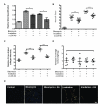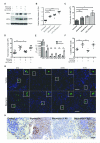LOX-mediated collagen crosslinking is responsible for fibrosis-enhanced metastasis
- PMID: 23345161
- PMCID: PMC3672851
- DOI: 10.1158/0008-5472.CAN-12-2233
LOX-mediated collagen crosslinking is responsible for fibrosis-enhanced metastasis
Expression of concern in
-
Editor's Note: LOX-Mediated Collagen Cross-linking Is Responsible for Fibrosis-Enhanced Metastasis.Cancer Res. 2019 Oct 1;79(19):5124. doi: 10.1158/0008-5472.CAN-19-2419. Cancer Res. 2019. PMID: 31575632 No abstract available.
Abstract
Tumor metastasis is a highly complex, dynamic, and inefficient process involving multiple steps, yet it accounts for more than 90% of cancer-related deaths. Although it has long been known that fibrotic signals enhance tumor progression and metastasis, the underlying molecular mechanisms are still unclear. Identifying events involved in creating environments that promote metastatic colonization and growth are critical for the development of effective cancer therapies. Here, we show a critical role for lysyl oxidase (LOX) in establishing a milieu within fibrosing tissues that is favorable to growth of metastastic tumor cells. We show that LOX-dependent collagen crosslinking is involved in creating a growth-permissive fibrotic microenvironment capable of supporting metastatic growth by enhancing tumor cell persistence and survival. We show that therapeutic targeting of LOX abrogates not only the extent to which fibrosis manifests, but also prevents fibrosis-enhanced metastatic colonization. Finally, we show that the LOX-mediated collagen crosslinking directly increases tumor cell proliferation, enhancing metastatic colonization and growth manifesting in vivo as increased metastasis. This is the first time that crosslinking of collagen I has been shown to enhance metastatic growth. These findings provide an important link between ECM homeostasis, fibrosis, and cancer with important clinical implications for both the treatment of fibrotic disease and cancer.
Figures






References
-
- Steeg PS. Tumor metastasis: mechanistic insights and clinical challenges. Nat Med. 2006;12:895–904. - PubMed
-
- Nguyen DX, Bos PD, Massague J. Metastasis: from dissemination to organ-specific colonization. Nat Rev Cancer. 2009;9:274–84. - PubMed
-
- Gupta GP, Massague J. Cancer metastasis: building a framework. Cell. 2006;127:679–95. - PubMed
-
- Fidler IJ. The pathogenesis of cancer metastasis: the ‘seed and soil’ hypothesis revisited. Nat Rev Cancer. 2003;3:453–8. - PubMed
Publication types
MeSH terms
Substances
Grants and funding
LinkOut - more resources
Full Text Sources
Other Literature Sources

